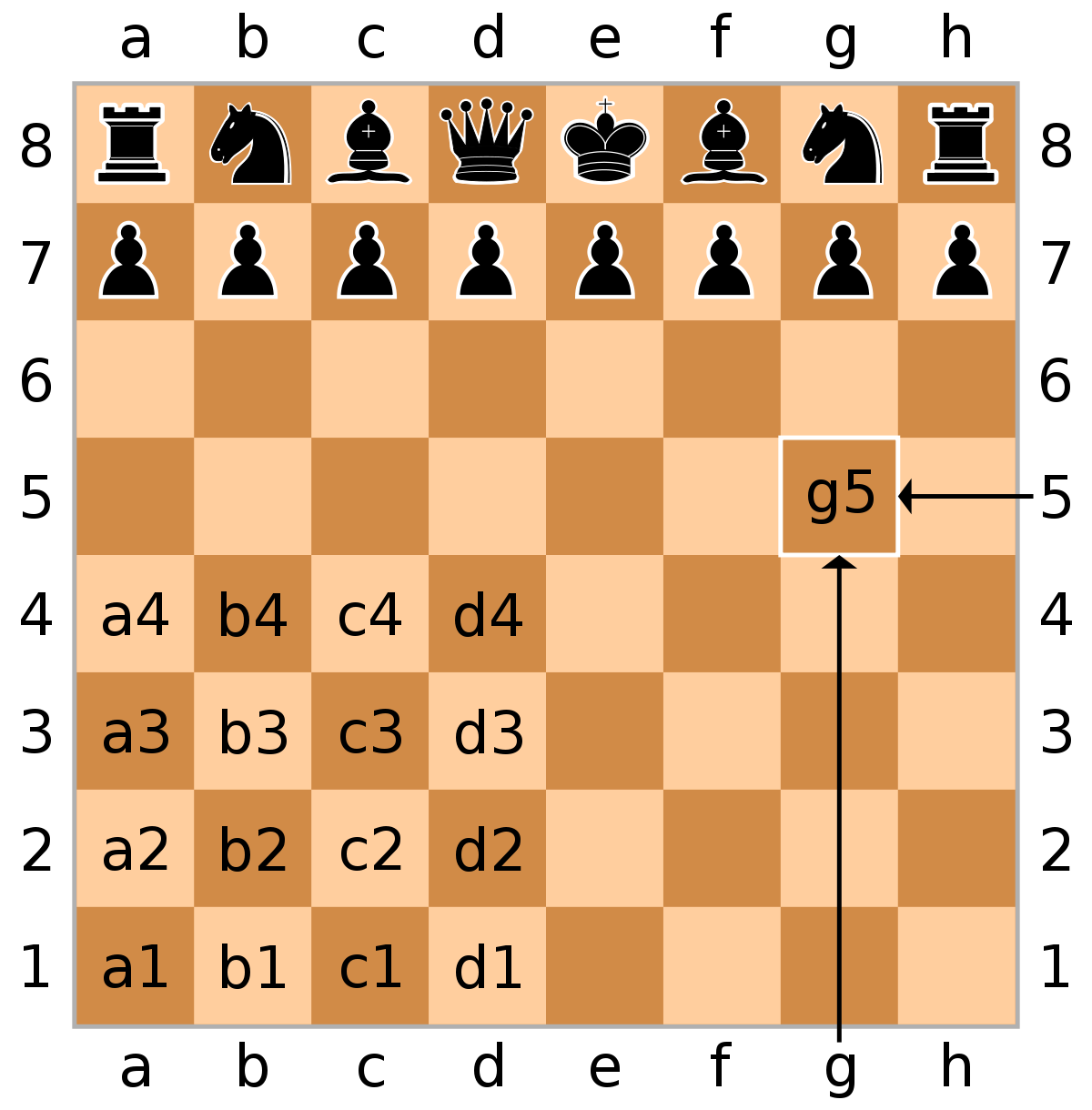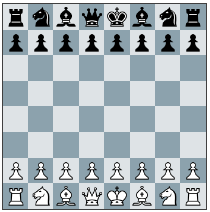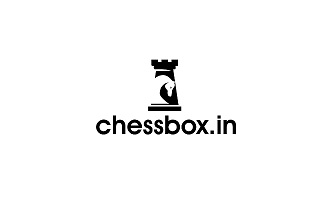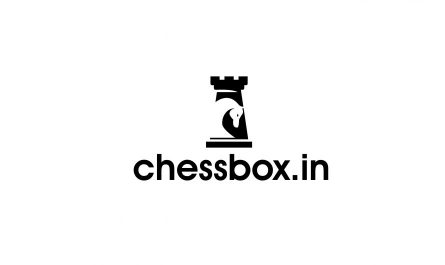Whether it is a home/ hobby/ travel chess game setup or a world championship tournament finale, a few standards are always observed. Lets understand where to start with chess board details, chess pieces, chess board setup and chess annotations.

A standard chessboard consists of 64 squares arranged in an 8×8 grid. The squares alternate between two colors, usually light and dark. The columns are labeled with letters from “a” to “h,” and the rows are numbered from 1 to 8.
Here’s how you set up a chessboard:

a b c d e f g h
8 r n b q k b n r
7 p p p p p p p p
6 . . . . . . . .
5 . . . . . . . .
4 . . . . . . . .
3 . . . . . . . .
2 P P P P P P P P
1 R N B Q K B N R
Key:
“K” represents the King.
“Q” represents the Queen.
“R” represents the Rook.
“N” represents the Knight.
“B” represents the Bishop.
“P” represents the Pawn.
“.” represents an empty square.
Two points to remember here:
The pieces in the back row are arranged from left to right in the order Rook, Knight, Bishop, Queen, King, Bishop, Knight, Rook for both white and black sides.
What’s Next?
Make sure to set up the board so that the bottom-right square is a light-colored square. This is the standard arrangement for a chessboard. Setting up a chessboard properly is important for a fair and enjoyable game. Here are some tips to help you set up a chessboard correctly:
- Orientation: Make sure the bottom-right square of the board is a light-colored square. This ensures that both players have a light-colored square in their right-hand corner.
- Piece Placement: Place the pieces on the board according to the standard setup, with the back rank having rooks, knights, bishops, queen, king, bishops, knights, and rooks from left to right for both sides.
- Centering: Ensure that the board is centered on the table so that both players have equal access to the board.
- Square Colors: When setting up the board, the bottom-right square should always be a light-colored square. The placement of the pieces should correspond to this color scheme.
- Piece Direction: The pieces should face towards the player, with the larger pieces (king and queen) in the center and the pawns in front.
- Consistency: Keep the squares and pieces consistent throughout the game. Avoid moving the board or pieces around once the game has started unless it’s necessary for gameplay.
- Table Space: Make sure there’s enough space around the board for both players to comfortably reach all the squares. Avoid crowding the playing area.
- Prominent Display: If you’re playing in a tournament or setting where others will observe the game, ensure the board is easily visible to onlookers. This might involve using a raised platform or ensuring the board is at an appropriate height.
- Lighting: Ensure that the lighting in the room is adequate for both players to see the board clearly. Avoid glare and shadows that could obstruct the view.
- Clock Placement: If using chess clocks, make sure they are positioned where both players can easily see their own time.
- Etiquette: When setting up the board, show respect for your opponent. Handle the pieces gently and avoid making distracting noises.
- Double-Check: Before starting the game, take a moment to double-check that all the pieces are in the correct positions. This can help avoid disputes later in the game.
Chessboard setup issues can lead to confusion, disputes, and an overall negative playing experience. Here are some common setup issues to be aware of and how to avoid them:
- Piece Misplacement: Placing pieces in the wrong squares or positions can lead to misunderstandings and disagreements. Double-check that the pieces are correctly positioned before starting the game.
- Incorrect Orientation: If the board is not oriented correctly (with the bottom-right square being a light-colored square), it can affect both players’ understanding of the board layout. Always ensure the proper orientation.
- Inaccurate Piece Direction: Pieces should be facing the right way, with the pawns in front of the other pieces and the king and queen in the center. Incorrect piece direction can lead to confusion during the game.
- Uneven Board Alignment: If the board isn’t centered or is positioned unevenly, it can lead to discomfort for both players. Make sure the board is placed centrally on the playing surface.
- Overcrowded Playing Area: A cluttered or cramped playing area can lead to accidental piece movements or difficulty in focusing on the game. Maintain enough space around the board for both players.
- Insufficient Lighting: Poor lighting conditions can make it difficult to see the board clearly. Ensure that the playing area is well-lit to avoid visual challenges.
- Missing or Extra Pieces: Before starting the game, ensure that all the pieces are present and accounted for. Missing pieces can disrupt the game, while extra pieces can cause confusion.
- Unstable Board or Pieces: A wobbly board or unstable pieces can be distracting and frustrating. Use a stable surface and make sure the pieces are secure.
- Setting Up Clocks Incorrectly: If using chess clocks, ensure that they’re properly set and positioned so that both players can monitor their time without difficulty.
- Ignoring Etiquette: Treat your opponent and their pieces with respect. Avoid knocking pieces over or making disruptive movements during setup.
Arrangement issues in a chess game can lead to misunderstandings, disputes, and affect the overall fairness of the match. Here are some common arrangement issues to watch out for and how to address them:
Illegal Move: Making a move that violates the rules of chess, such as moving a piece in a way it’s not allowed, can cause confusion and disrupt the game. Always make sure your moves adhere to the rules.
Piece Misplacement During Play: Accidentally moving a piece to the wrong square or knocking over pieces can lead to disagreements. Be careful when executing your moves to avoid mistakes.
Unclear or Ambiguous Moves: If a move isn’t clearly stated or understood by both players, it can lead to confusion. Clearly announce your moves and use standard notation (e.g., “Nf3” for moving a knight to f3).
Touch-Move Rule Violation: If you touch a piece, you generally must move it if it’s a legal move. Accidental touches can lead to disputes if the opponent thinks you’ve committed to moving that piece.
Missing Captures: Failing to capture an opponent’s piece when you have a legal opportunity can be an issue. Make sure to be aware of possible captures and threats.
En Passant Misunderstanding: En passant captures involve specific rules. If you or your opponent misunderstands this rule, it can lead to disputes.
Castling Mistakes: Castling involves specific conditions, including no pieces between the king and rook and the king not being in check. Misinterpreting these conditions can cause problems.
Promotion Uncertainty: When a pawn reaches the opposite end of the board, it can be promoted to any other piece (except a king). Clearly indicate what piece you’re promoting to prevent confusion.
Repeating Moves: If the same position occurs three times with the same player to move, a draw can be claimed. Keep track of positions to avoid misunderstandings.
Clock Management: Incorrectly managing chess clocks can lead to time-related disputes. Understand how the clocks work and keep track of your time accurately.
Agreeing to Draws: Players need to communicate clearly if they want to offer or accept a draw. Unclear communication about draws can lead to disagreements.
Disruptive Behavior: Making distracting noises, using offensive language, or behaving inappropriately can affect the game’s atmosphere. Maintain a respectful demeanor.
To prevent these arrangement issues, it’s important to have a solid understanding of the rules of chess, practice good sportsmanship, and communicate effectively with your opponent. If a disagreement arises during a game, try to resolve it calmly and refer to the official rules if needed. Clear communication and mutual respect are key to a successful and enjoyable chess match.
Each type of chess piece has specific rules governing how it can move on the board. Here’s a breakdown of how each chess piece moves:
- Pawn (P): Pawns move forward one square but capture diagonally. On their first move, pawns have the option to move forward two squares. When a pawn reaches the opposite end of the board, it can be promoted to any other piece (except a king).
- Rook (R): Rooks move horizontally or vertically across the board any number of empty squares. They cannot jump over other pieces.
- Knight (N): Knights move in an “L” shape: two squares in one direction (horizontally or vertically) and then one square perpendicular to the first direction. Knights are the only pieces that can jump over other pieces on the board.
- Bishop (B): Bishops move diagonally across the board any number of empty squares. Each player starts with two bishops, one on light squares and one on dark squares.
- Queen (Q): The queen is the most powerful piece. It combines the abilities of the rook and bishop, moving horizontally, vertically, and diagonally across the board any number of empty squares.
- King (K): The king moves one square in any direction: horizontally, vertically, or diagonally. The king is also involved in a special move called castling, which allows it to move two squares towards a rook, followed by that rook moving to the square the king skipped over.
Remember that pieces can’t move through squares occupied by their own pieces, but they can capture opponent’s pieces by moving to their squares. Also, a king cannot move to a square that is attacked by an opponent’s piece.
Additionally, there are a few special rules and moves:
Castling: The king and one of the rooks can be moved in a single move called castling. The conditions for castling are: neither the king nor the chosen rook has previously moved, there are no pieces between the king and rook, the king is not in check, and the squares the king moves through or lands on are not attacked by opponent’s pieces.
En Passant: If a pawn moves two squares forward from its starting position and lands next to an opponent’s pawn, the opponent has the option to capture the pawn as if it had only moved one square forward.
Check: When a king is under direct threat of capture, it is said to be in check. The player must make a move that removes the threat.
Checkmate: If a player’s king is in check and there is no legal move that can remove the threat, it is checkmate, and the game ends with that player losing.
Chess notation is a standardized way of recording and communicating chess moves using a combination of letters and numbers. It allows players to document their games and analyze positions more easily. Here’s a brief overview of algebraic notation, which is the most common form of chess notation:
Chess Piece Abbreviations:
K = King
Q = Queen
R = Rook
N = Knight
B = Bishop
P = Pawn
File and Rank:
1.) Files are labeled with letters from “a” to “h,” from left to right.
2.) Ranks are labeled with numbers from 1 to 8, from bottom to top.
Recording Moves:
Moves are recorded by specifying the piece abbreviation followed by the destination square (file and rank).
If there’s ambiguity about which piece should move to a particular square, you can use the starting square before the destination square (e.g., Nf3 or Ndf3).
Captures: Use “x” to indicate a capture. For example, Bxe5 means the bishop captures the piece on e5.
Pawn Moves: For pawn moves, only the destination square is indicated. For example, e4 means a pawn moves to e4.
Pawn Promotion: When a pawn reaches the opposite end of the board, indicate the promotion piece after the move. For example, e8=Q indicates that a pawn on e8 was promoted to a queen.
Castling: Kingside castling is represented as “0-0,” and queenside castling is represented as “0-0-0.”
Check and Checkmate:
“+” indicates check.
“#” indicates checkmate.
Sample Notation:
e4 (pawn to e4)
Nf3 (knight to f3)
Bxe5 (bishop captures on e5)
O-O (kingside castling)
O-O-O (queenside castling)
Nxd5+ (knight captures on d5 with check)
Qd8# (queen delivers checkmate on d8)

